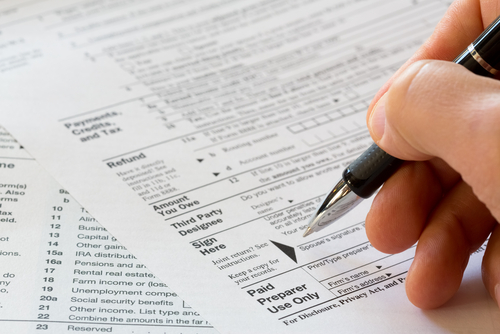While many Americans celebrated the dawn of a new year, members of the U.S. Senate remained in Washington, D.C. In response to the looming fiscal cliff crisis—tax increases and budget cuts, the Senators got busy and finally hammered out a budget agreement that includes new tax rates.
The senate passed The American Taxpayer Relief Act of 2013 on New Year’s Eve. House members passed the legislation the next day.
Here are the tax rate changes effective this year:
High-income Households
Single households making more than $400,000 and married filing joint households exceeding $450,000 experienced a tax rate bracket increase from 35% to 39.6%. This change does not affect your 2012 income tax return.
Payroll Tax Holiday Expiration
The 2% payroll tax increase that Americans experienced in the first paycheck of 2013 had the same effect as a tax increase. The payroll tax holiday, which applied to the 2011 and 2012 tax years, reduced the effective rate for the employee’s portion of the taxes for funding the Social Security system from 6.2% to 4.2%. The ATRA also raised the wage ceiling on payroll taxes to $113,700.
Pease Rule Changes
High income taxpayers also received another indirect hike in their tax rates. The Pease rule, which is named after congressman who introduced the bill, place limitations on itemized deductions. It reduces the deductable amount by 3% of the amount by which it exceeds adjustable gross income. It has a cap of 80 percent of itemized deductions. The 2001 tax act repealed the rule in 2010, but it was reinstated through 2012.
The ATRA raises the income level at which the Pease rule becomes effective. The rule starts at the same income level as the personal exemption phase out.
Here are the income levels:
- Single: $250,000
- Head of household: $275,000
- Married filing jointly: $300,000
- Married filing separately: $150,000
The new rule adds an inflation index after 2013. Since adjusted gross income does not include capital gains, Pease cannot be triggered by capital gain income.
Deductions for medical expenses, investment interest, casualty and theft losses, or gambling losses do not apply. Keep in mind that the Pease rule only applies to taxpayers with adjusted gross incomes that exceed the thresholds listed above.
Capital Gains and Investment Income
Single households who have incomes that exceed $400,000 and joint filers with incomes in excess of $450,000 will pay 5% more in capital gains taxes. The capital gains tax rate increase from 15% to 20%.
In addition, these household earners are subject to a 3.8% surcharge on investment income– interest, dividends, rental income, and capital gains as mandated by the Affordable Care Act.
Estate and Gift Taxes
The new tax rules retain the same regulations applicable to estates in 2012. An individual can receive up to a $5 million exemption. The inflation index increases the exclusion to $5.25 million. Individuals can use the exemption for estate tax or gift tax exclusions and lower their effective tax rates. They can also apply the exclusion to a combination of the two items. The top gift tax rate dropped from 55% to 40%.
While many Americans celebrated the dawn of a new year, members of the U.S. Senate remained in Washington, D.C. In response to the looming fiscal cliff crisis—tax increases and budget cuts, the Senators got busy and finally hammered out a budget agreement that includes new tax rates.
The senate passed The American Taxpayer Relief Act of 2013 on New Year’s Eve. House members passed the legislation the next day.
Here are the tax rate changes effective this year:
High-income Households
Single households making more than $400,000 and married filing joint households exceeding $450,000 experienced a tax rate bracket increase from 35% to 39.6%. This change does not affect your 2012 income tax return.
Payroll Tax Holiday Expiration
The 2% payroll tax increase that Americans experienced in the first paycheck of 2013 had the same effect as a tax increase. The payroll tax holiday, which applied to the 2011 and 2012 tax years, reduced the effective rate for the employee’s portion of the taxes for funding the Social Security system from 6.2% to 4.2%. The ATRA also raised the wage ceiling on payroll taxes to $113,700.
Pease Rule Changes
High income taxpayers also received another indirect hike in their tax rates. The Pease rule, which is named after congressman who introduced the bill, place limitations on itemized deductions. It reduces the deductable amount by 3% of the amount by which it exceeds adjustable gross income. It has a cap of 80 percent of itemized deductions. The 2001 tax act repealed the rule in 2010, but it was reinstated through 2012.
The ATRA raises the income level at which the Pease rule becomes effective. The rule starts at the same income level as the personal exemption phase out.
Here are the income levels:
- Single: $250,000
- Head of household: $275,000
- Married filing jointly: $300,000
- Married filing separately: $150,000
The new rule adds an inflation index after 2013. Since adjusted gross income does not include capital gains, Pease cannot be triggered by capital gain income.
Deductions for medical expenses, investment interest, casualty and theft losses, or gambling losses do not apply. Keep in mind that the Pease rule only applies to taxpayers with adjusted gross incomes that exceed the thresholds listed above.
Capital Gains and Investment Income
Single households who have incomes that exceed $400,000 and joint filers with incomes in excess of $450,000 will pay 5% more in capital gains taxes. The capital gains tax rate increase from 15% to 20%.
In addition, these household earners are subject to a 3.8% surcharge on investment income– interest, dividends, rental income, and capital gains as mandated by the Affordable Care Act.
Estate and Gift Taxes
The new tax rules retain the same regulations applicable to estates in 2012. An individual can receive up to a $5 million exemption. The inflation index increases the exclusion to $5.25 million. Individuals can use the exemption for estate tax or gift tax exclusions and lower their effective tax rates. They can also apply the exclusion to a combination of the two items. The top gift tax rate dropped from 55% to 40%.







